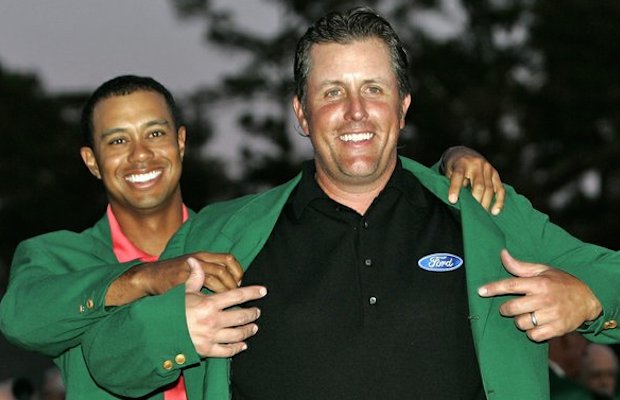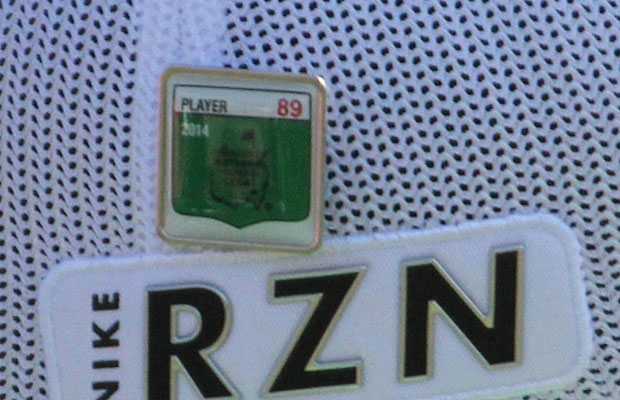Opinion & Analysis
Who will succeed Woods and Mickelson as multiple Masters winners?

As you know, Tiger Woods isn’t participating in the Masters this year as he recovers from back surgery. Phil Mickelson, hampered by injuries of his own, is limiting his practice in preparation for the season’s first major.
Woods has been a member of the PGA Tour since 1996. Mickelson, for his part, began teeing it up on Tour in 1992. Thus, for the better part of 20 years, the Woods-Mickelson duo have been the top-billed act in professional golf (along with a revolving cast of supporting star).
Much like Ian McKellan and Patrick Stewart, though, who ended their run of No Man’s Land on Broadway this week with an assortment of fabulous photos at New York City landmarks, Tiger and Phil will soon enough be removed from the list of serious contenders for the green jacket.
It’s neither clear who will step up to fill the void on Broadway or inside the ropes at Augusta in the near future.
It seems like Tiger’s “Hello, world” speech was yesterday. Likewise, a fresh-faced Phil Mickelson with much more closely cropped hair seems to just have faded from view. Yet those moments were many years ago and Woods and Mickelson have been dealing with issues that rarely seem to trouble younger men.
After pursuing less invasive solutions, Tiger Woods elected to have back surgery for a bulging disk at the end of March. The disk problem and related back issues have plagued Woods this year. Prior to the surgery, the world No. 1 was off to the worst start to a season of near 20-year professional career.
Mickelson, for his part, has withdrawn twice this year due to injury. While he’s made eight of nine cuts and finishing inside the top 25 five times, the 42-time Tour winner has finished no higher than 12th in an event this year.
Tiger Woods has been a participant in the Masters since 1995, when he was the low amateur in the competition. He first won at Augusta in 1997, and his most recent green jacket came in 2005. It’s equally difficult to believe that Tiger Woods has been playing in the Masters for nearly 20 years as it is to get one’s head around the fact that it’s been nearly 10 years since he won the competition.
Woods is now 38 years old. Assuming he recovers quickly and without incident from this surgery, he can’t have more than another 10 years of peak golf left in him. And Mickelson, 43, likely won’t be a contender for much more than the next five years. Even if he manages to creep up the leaderboard at age 48 or 49, the truth is the same: The era of Woods and Mickelson is drawing to a close.
With all of this in mind, it’s fitting to ask: “What’s next? Who will the next multiple Masters winner be?”
Here’s a look at the last five winners of the Masters and their current ages (skipping Mickelson in 2010):
- Adam Scott: 33
- Bubba Watson: 35
- Charl Schwartzel: 29
- Angel Cabrera: 44
- Trevor Immelman: 34
How many of the above are likely to win another Masters? Adam Scott, now with the major monkey off his back, and Bubba Watson seem to be the most likely. Charl Schwartzel is yet to follow up his Masters victory with another win on the PGA Tour, and he hasn’t finished inside the top 20 at Augusta since winning the green jacket in 2011.
Tiger Woods has won the Masters four times in 17 attempts as a professional. In 20 tries as a pro, Mickelson has won three times. It seems plausible given these rates that Scott, Watson, and Schwartzel could all win another Masters. But several more? I’m not convinced given what I’ve seen from Watson and Schwartzel. Scott, for his part, notched top 10s at both the Open Championship and the PGA Championship last season after his Masters win. The Australian seems to most ready of the bunch to win a bunch of majors, as it were.
But who else?
Looking at the top-10 (ish) finishers from the last three years, here are the players who are still around 35 or under and their career finishes at the Masters:

Of all the players on this list, Jason Day and Adam Scott have performed the best recently. Matt Kuchar, too, has been strong and Brandt Snedeker has been as well. After these four, though, what other (relative) youngster looks primed for a green jacket? Based on recent past performance the list is a short one.
Let’s have a look at the “others.”
A tie for sixth in one’s opening Masters is an incredible achievement. However, it’s difficult to assume that Thorbjorn Olesen will step to the fore and win the tournament when he’s yet to win on the PGA Tour and has missed three of five cuts this season.
Charl Schwartzel has made four of five cuts this season and finished inside the top 10 twice. After a solid, but not spectacular 2013, Schwartzel seems steady, but not exactly poised for a streak of dominance.
Dustin Johnson does not as of yet seem to have the essential major-winning mettle.
John Huh is in the same boat as Mr. Olesen.
Justin Rose needs to ghost of Bobby Locke to possess his putting grip if he’s going to win another major, and his performance this year doesn’t scream “Hand me the green jacket!”
Louis Oosthuizen: How can you lose the Masters in a playoff on one occasion and miss the cut in your other four attempts?
I’m convinced that no matter how well or poorly Luke Donald is playing entering a major, he’s never going to win one of the darn things. His attire will eternally outshine his play down the stretch.
Marc Leishman played inspired golf last year. However, as he missed the cut in his other go-round in Georgia, it’s difficult to thing that he’s ready to make the quantum leap forward to Masters winner.
Perhaps Sergio Garcia has forgotten the comments below and is found the necessary fortitude to keep it together for 72 holes at Augusta.
“I’m not good enough … I don’t have the thing I need to have. In 13 years I’ve come to the conclusion that I need to play for second or third place.”
I’m skeptical that Garcia has found “the thing he needs to have” to win one major. I’m equally skeptical that the majority of the players on this list have found that truly rare substance in professional golf that both Tiger Woods and Phil Mickelson possess: the ability to win multiple Masters Tournaments.
Opinion & Analysis
The 2 primary challenges golf equipment companies face

As the editor-in-chief of this website and an observer of the GolfWRX forums and other online golf equipment discourse for over a decade, I’m pretty well attuned to the grunts and grumbles of a significant portion of the golf equipment purchasing spectrum. And before you accuse me of lording above all in some digital ivory tower, I’d like to offer that I worked at golf courses (public and private) for years prior to picking up my pen, so I’m well-versed in the non-degenerate golf equipment consumers out there. I touched (green)grass (retail)!
Complaints about the ills of and related to the OEMs usually follow some version of: Product cycles are too short for real innovation, tour equipment isn’t the same as retail (which is largely not true, by the way), too much is invested in marketing and not enough in R&D, top staffer X hasn’t even put the new driver in play, so it’s obviously not superior to the previous generation, prices are too high, and on and on.
Without digging into the merits of any of these claims, which I believe are mostly red herrings, I’d like to bring into view of our rangefinder what I believe to be the two primary difficulties golf equipment companies face.
One: As Terry Koehler, back when he was the CEO of Ben Hogan, told me at the time of the Ft Worth irons launch, if you can’t regularly hit the golf ball in a coin-sized area in the middle of the face, there’s not a ton that iron technology can do for you. Now, this is less true now with respect to irons than when he said it, and is less and less true by degrees as the clubs get larger (utilities, fairways, hybrids, drivers), but there remains a great deal of golf equipment truth in that statement. Think about it — which is to say, in TL;DR fashion, get lessons from a qualified instructor who will teach you about the fundamentals of repeatable impact and how the golf swing works, not just offer band-aid fixes. If you can’t repeatably deliver the golf club to the golf ball in something resembling the manner it was designed for, how can you expect to be getting the most out of the club — put another way, the maximum value from your investment?
Similarly, game improvement equipment can only improve your game if you game it. In other words, get fit for the clubs you ought to be playing rather than filling the bag with the ones you wish you could hit or used to be able to hit. Of course, don’t do this if you don’t care about performance and just want to hit a forged blade while playing off an 18 handicap. That’s absolutely fine. There were plenty of members in clubs back in the day playing Hogan Apex or Mizuno MP-32 irons who had no business doing so from a ballstriking standpoint, but they enjoyed their look, feel, and complementary qualities to their Gatsby hats and cashmere sweaters. Do what brings you a measure of joy in this maddening game.
Now, the second issue. This is not a plea for non-conforming equipment; rather, it is a statement of fact. USGA/R&A limits on every facet of golf equipment are detrimental to golf equipment manufacturers. Sure, you know this, but do you think about it as it applies to almost every element of equipment? A 500cc driver would be inherently more forgiving than a 460cc, as one with a COR measurement in excess of 0.83. 50-inch shafts. Box grooves. And on and on.
Would fewer regulations be objectively bad for the game? Would this erode its soul? Fortunately, that’s beside the point of this exercise, which is merely to point out the facts. The fact, in this case, is that equipment restrictions and regulations are the slaughterbench of an abundance of innovation in the golf equipment space. Is this for the best? Well, now I’ve asked the question twice and might as well give a partial response, I guess my answer to that would be, “It depends on what type of golf you’re playing and who you’re playing it with.”
For my part, I don’t mind embarrassing myself with vintage blades and persimmons chasing after the quasi-spiritual elevation of a well-struck shot, but that’s just me. Plenty of folks don’t give a damn if their grooves are conforming. Plenty of folks think the folks in Liberty Corner ought to add a prison to the museum for such offences. And those are just a few of the considerations for the amateur game — which doesn’t get inside the gallery ropes of the pro game…
Different strokes in the game of golf, in my humble opinion.
Anyway, I believe equipment company engineers are genuinely trying to build better equipment year over year. The marketing departments are trying to find ways to make this equipment appeal to the broadest segment of the golf market possible. All of this against (1) the backdrop of — at least for now — firm product cycles. And golfers who, with their ~15 average handicap (men), for the most part, are not striping the golf ball like Tiger in his prime and seem to have less and less time year over year to practice and improve. (2) Regulations that massively restrict what they’re able to do…
That’s the landscape as I see it and the real headwinds for golf equipment companies. No doubt, there’s more I haven’t considered, but I think the previous is a better — and better faith — point of departure when formulating any serious commentary on the golf equipment world than some of the more cynical and conspiratorial takes I hear.
Agree? Disagree? Think I’m worthy of an Adam Hadwin-esque security guard tackle? Let me know in the comments.
@golfoncbs The infamous Adam Hadwin tackle ? #golf #fyp #canada #pgatour #adamhadwin ? Ghibli-style nostalgic waltz – MaSssuguMusic
Podcasts
Fore Love of Golf: Introducing a new club concept

Episode #16 brings us Cliff McKinney. Cliff is the founder of Old Charlie Golf Club, a new club, and concept, to be built in the Florida panhandle. The model is quite interesting and aims to make great, private golf more affordable. We hope you enjoy the show!
Opinion & Analysis
On Scottie Scheffler wondering ‘What’s the point of winning?’

Last week, I came across a reel from BBC Sport on Instagram featuring Scottie Scheffler speaking to the media ahead of The Open at Royal Portrush. In it, he shared that he often wonders what the point is of wanting to win tournaments so badly — especially when he knows, deep down, that it doesn’t lead to a truly fulfilling life.
View this post on Instagram
“Is it great to be able to win tournaments and to accomplish the things I have in the game of golf? Yeah, it brings tears to my eyes just to think about it because I’ve literally worked my entire life to be good at this sport,” Scheffler said. “To have that kind of sense of accomplishment, I think, is a pretty cool feeling. To get to live out your dreams is very special, but at the end of the day, I’m not out here to inspire the next generation of golfers. I’m not out here to inspire someone to be the best player in the world, because what’s the point?”
Ironically — or perhaps perfectly — he went on to win the claret jug.
That question — what’s the point of winning? — cuts straight to the heart of the human journey.
As someone who’s spent over two decades in the trenches of professional golf, and in deep study of the mental, emotional, and spiritual dimensions of the game, I see Scottie’s inner conflict as a sign of soul evolution in motion.
I came to golf late. I wasn’t a junior standout or college All-American. At 27, I left a steady corporate job to see if I could be on the PGA Tour starting as a 14-handicap, average-length hitter. Over the years, my journey has been defined less by trophies and more by the relentless effort to navigate the deeply inequitable and gated system of professional golf — an effort that ultimately turned inward and helped me evolve as both a golfer and a person.
One perspective that helped me make sense of this inner dissonance around competition and our culture’s tendency to overvalue winning is the idea of soul evolution.
The University of Virginia’s Division of Perceptual Studies has done extensive research on reincarnation, and Netflix’s Surviving Death (Episode 6) explores the topic, too. Whether you take it literally or metaphorically, the idea that we’re on a long arc of growth — from beginner to sage elder — offers a profound perspective.
If you accept the premise literally, then terms like “young soul” and “old soul” start to hold meaning. However, even if we set the word “soul” aside, it’s easy to see that different levels of life experience produce different worldviews.
Newer souls — or people in earlier stages of their development — may be curious and kind but still lack discernment or depth. There is a naivety, and they don’t yet question as deeply, tending to see things in black and white, partly because certainty feels safer than confronting the unknown.
As we gain more experience, we begin to experiment. We test limits. We chase extreme external goals — sometimes at the expense of health, relationships, or inner peace — still operating from hunger, ambition, and the fragility of the ego.
It’s a necessary stage, but often a turbulent and unfulfilling one.
David Duval fell off the map after reaching World No. 1. Bubba Watson had his own “Is this it?” moment with his caddie, Ted Scott, after winning the Masters.
In Aaron Rodgers: Enigma, reflecting on his 2011 Super Bowl win, Rodgers said:
“Now I’ve accomplished the only thing that I really, really wanted to do in my life. Now what? I was like, ‘Did I aim at the wrong thing? Did I spend too much time thinking about stuff that ultimately doesn’t give you true happiness?’”
Jim Carrey once said, “I think everybody should get rich and famous and do everything they ever dreamed of so they can see that it’s not the answer.”
Eventually, though, something shifts.
We begin to see in shades of gray. Winning, dominating, accumulating—these pursuits lose their shine. The rewards feel more fleeting. Living in a constant state of fight-or-flight makes us feel alive, yes, but not happy and joyful.
Compassion begins to replace ambition. Love, presence, and gratitude become more fulfilling than status, profits, or trophies. We crave balance over burnout. Collaboration over competition. Meaning over metrics.
Interestingly, if we zoom out, we can apply this same model to nations and cultures. Countries, like people, have a collective “soul stage” made up of the individuals within them.
Take the United States, for example. I’d place it as a mid-level soul: highly competitive and deeply driven, but still learning emotional maturity. Still uncomfortable with nuance. Still believing that more is always better. Despite its global wins, the U.S. currently ranks just 23rd in happiness (as of 2025). You might liken it to a gifted teenager—bold, eager, and ambitious, but angsty and still figuring out how to live well and in balance. As much as a parent wants to protect their child, sometimes the child has to make their own mistakes to truly grow.
So when Scottie Scheffler wonders what the point of winning is, I don’t see someone losing strength.
I see someone evolving.
He’s beginning to look beyond the leaderboard. Beyond metrics of success that carry a lower vibration. And yet, in a poetic twist, Scheffler did go on to win The Open. But that only reinforces the point: even at the pinnacle, the question remains. And if more of us in the golf and sports world — and in U.S. culture at large — started asking similar questions, we might discover that the more meaningful trophy isn’t about accumulating or beating others at all costs.
It’s about awakening and evolving to something more than winning could ever promise.


















Deaus
Apr 10, 2014 at 5:35 pm
IMO Oosthuizen should win a few in his career as long as he stays healthy, same with Charl. They both have complete games, especially Lious. Rory should be able to snatch a few jackets as well. I would be surprised to see Bubba win another major let alone green jacket.
Deaus
Apr 13, 2014 at 8:57 pm
Looks like i was dead wrong. Nice win Bubba!!
dapadre
Apr 9, 2014 at 1:27 pm
With Tiger not being around, all this goes out the door. The will be keen to perform as that ONE MAIN obstacle is out the way. Yes he was not playing his best, but his presence will always be a factor. I foresee a great tournament with Rors battling it out with top contenders, including Garcia who I think finally has a shot a this.
BS
Apr 10, 2014 at 2:25 am
He probably doesn’t have a back problem. He probably skipped out on this year’s Masters because he knows everybody in the locker room will be talking about how he cheated last year with his drop on 15, and he probably decided he didn’t want to deal with the BS